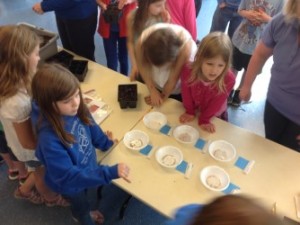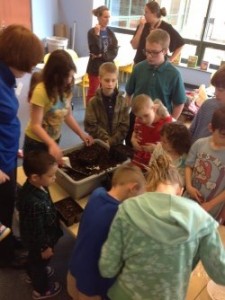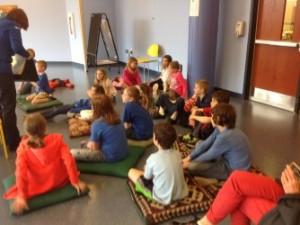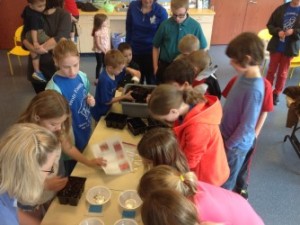We recently made use of Spring Break to host a program presented by our local agricultural Extension Agent. The horticulture agent came to our library to present a program all about tomatoes! She and her assistant talked about different varieties of tomatoes, a little bit of the history of the tomato, what they need to grow successfully, and how to care for the plants. The program was scheduled at 2:00 pm on a weekday, with the idea that it would be accessible for the students out of school for spring break. However, it was also advertised directly to the home schoolers in the area, and they turned out to be the bulk of those in attendance. Our flyer advertised the program for ages 6-12, but encouraged younger or older to siblings to attend as well.
Since the kids were to be planting tomato seeds to take home, it was stated that each family would be limited to one 6-cell pack regardless of the number of students who attended per family. This worked very well, and since this was advertised in the program information, families were aware of it from the beginning. This made an excellent opportunity to bring math into the program; the agent talked with the kids about why you plant more than one of each seed, how many seeds would go into each cell, and how many seeds total would be in the pack. She even talked about thinning the seedlings and did the math with the students regarding how many actual plants would most likely be planted later. She also took this opportunity to do the math for the seed sprouting time, how many days until planting outdoors, and more.
The extension agent brought all the necessary materials with her, including the cell packs for planting, the planting soil mix, seeds for 6 different varieties of tomato plants, plant marking tags, and booklets regarding home gardening ideas and plans. After the information session and some questions and answers, they also talked about the types of lighting required for starting the seeds at home. They even brought sample lights, so the parents would know for sure if they have something at home that will work. For the information part of the program, she used a flip chart and a story time approach, which worked well with the variety of ages attending. The majority of the kids were in the 6-10 age range, with a few who were older and a few younger.
 Following the talk, the kinds of tomatoes represented by the various seeds were described. There were beefsteak tomatoes, romas, grape tomatoes, and even a yellow tomato represented. The agents were careful to explain the differences in sizes for the mature fruits and the plants; and described as well what the various varieties are most often used for, like salads, sandwiches, or sauces. She even discussed relative acid content and number of seeds in the fruits!
Following the talk, the kinds of tomatoes represented by the various seeds were described. There were beefsteak tomatoes, romas, grape tomatoes, and even a yellow tomato represented. The agents were careful to explain the differences in sizes for the mature fruits and the plants; and described as well what the various varieties are most often used for, like salads, sandwiches, or sauces. She even discussed relative acid content and number of seeds in the fruits!
The kids were then given their planting instructions, and it was again  explained that each family in attendance was limited to one 6-cell pack. They were allowed to choose which seeds they wanted to grow, and while some chose one of each, some chose only specific varieties according to their uses or size or space requirements. They got to fill the packs with soil, select and plant the seeds, then mist them with water. The kids were assisted in making variety name tags for each cell, so that when the seeds sprout, they’ll know which variety is in each cell. Before leaving, students were given gallon-sized zip bags in which to carry home the cell packs, helping to ensure they all made it home intact.
explained that each family in attendance was limited to one 6-cell pack. They were allowed to choose which seeds they wanted to grow, and while some chose one of each, some chose only specific varieties according to their uses or size or space requirements. They got to fill the packs with soil, select and plant the seeds, then mist them with water. The kids were assisted in making variety name tags for each cell, so that when the seeds sprout, they’ll know which variety is in each cell. Before leaving, students were given gallon-sized zip bags in which to carry home the cell packs, helping to ensure they all made it home intact.
The agents worked very well with the students. They included correct horticultural vocabulary, and encouraged the kids to repeat new and unknown words. The families all seemed to be very pleased with the experience and with their new baby tomato gardens! Several of the parents indicated they had learned quite a bit themselves. A variety of gardening books was also made available for check out, and each family which had pre-registered was given a copy of the garden guide the agents brought with them. Perhaps one of the best things about this program for the library was that all materials were provided by the extension office free of charge.
Hopefully by Mother’s Day, there will be a lot of baby tomato plants ready to be re-potted into bigger containers!






Leave A Comment